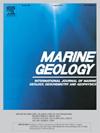植被置换对三沙湾滨海湿地有机碳埋藏的影响
IF 2.2
3区 地球科学
Q2 GEOSCIENCES, MULTIDISCIPLINARY
引用次数: 0
摘要
沿海湿地是必不可少但脆弱的碳汇;然而,植被更替对碳动态的影响尚不清楚。研究了福建三沙湾不同湿地类型(红树林、互花米草、滩涂)沉积有机碳(OC)的来源、埋藏速率和历史趋势。对沉积物岩心进行了地球化学(TOC、TN、δ13C)和放射性核素(210Pb、137Cs)代用分析。结果表明,河流输入是OC的主要来源,贡献了51 - 75%。红树林生态系统的碳埋藏率最高,为163±49 g/m2/yr,其次是南湖湿地(115±16 g/m2/yr)和荒滩(69±13 g/m2/yr)。然而,从1999年到2018年,人类干预,特别是土地开垦和沙藻的入侵,导致整个海湾的OC埋葬率下降了13.64%。虽然沙杉增强了当地的碳固存,但它的入侵破坏了红树林生态系统,破坏了现有碳库的稳定。本研究强调了植被变化对沿海碳动态的双重影响:入侵物种可能暂时提高碳埋藏率,但最终会破坏生态系统的长期恢复能力。为了维持蓝碳的功能,我们提倡优先保护红树林,恢复退化的湿地,并遏制褐藻的传播。这些发现为在快速变化的沿海环境中平衡碳减排努力和生物多样性保护提供了有价值的见解。本文章由计算机程序翻译,如有差异,请以英文原文为准。
Impacts of vegetation replacement on organic carbon burial in coastal wetlands of Sansha Bay, Southeast China
Coastal wetlands are essential yet vulnerable carbon sinks; however, the impacts of vegetation replacement on carbon dynamics remain less understood. This study investigates the sources, burial rates, and historical trends of sedimentary organic carbon (OC) across various wetland types, including mangroves, Spartina alterniflora (S. A.), and barren tidal flats in Sansha Bay, Fujian Province, Southeast China. We analyzed sediment cores for geochemical (TOC, TN, δ13C) and radionuclide (210Pb, 137Cs) proxies. Our results reveal that riverine inputs are the primary sources of OC, contributing 51–75 % of the total. The mangrove ecosystem exhibits the highest OC burial rate at163 ± 49 g/m2/yr, followed by the S. A. marshland at 115 ± 16 g/m2/yr, and barren flats at 69 ± 13 g/m2/yr. However, human interventions, particularly land reclamation and the invasion of S. A., have resulted in a 13.64 % decrease in the bay-wide OC burial rate from 1999 to 2018. While S. A. enhances local carbon sequestration, its invasion disrupts mangrove ecosystems and destabilizes existing carbon pools. This study underscores the dual impact of vegetation changes on coastal carbon dynamics: invasive species may temporarily enhance OC burial rates but ultimately undermine long-term ecosystem resilience. To maintain blue carbon functions, we advocate prioritizing mangrove conservation, restoring degraded wetlands, and curbing the spread of S. A. These findings provide valuable insights for balancing carbon mitigation efforts and biodiversity conservation in rapidly changing coastal environments.
求助全文
通过发布文献求助,成功后即可免费获取论文全文。
去求助
来源期刊

Marine Geology
地学-地球科学综合
CiteScore
6.10
自引率
6.90%
发文量
175
审稿时长
21.9 weeks
期刊介绍:
Marine Geology is the premier international journal on marine geological processes in the broadest sense. We seek papers that are comprehensive, interdisciplinary and synthetic that will be lasting contributions to the field. Although most papers are based on regional studies, they must demonstrate new findings of international significance. We accept papers on subjects as diverse as seafloor hydrothermal systems, beach dynamics, early diagenesis, microbiological studies in sediments, palaeoclimate studies and geophysical studies of the seabed. We encourage papers that address emerging new fields, for example the influence of anthropogenic processes on coastal/marine geology and coastal/marine geoarchaeology. We insist that the papers are concerned with the marine realm and that they deal with geology: with rocks, sediments, and physical and chemical processes affecting them. Papers should address scientific hypotheses: highly descriptive data compilations or papers that deal only with marine management and risk assessment should be submitted to other journals. Papers on laboratory or modelling studies must demonstrate direct relevance to marine processes or deposits. The primary criteria for acceptance of papers is that the science is of high quality, novel, significant, and of broad international interest.
 求助内容:
求助内容: 应助结果提醒方式:
应助结果提醒方式:


